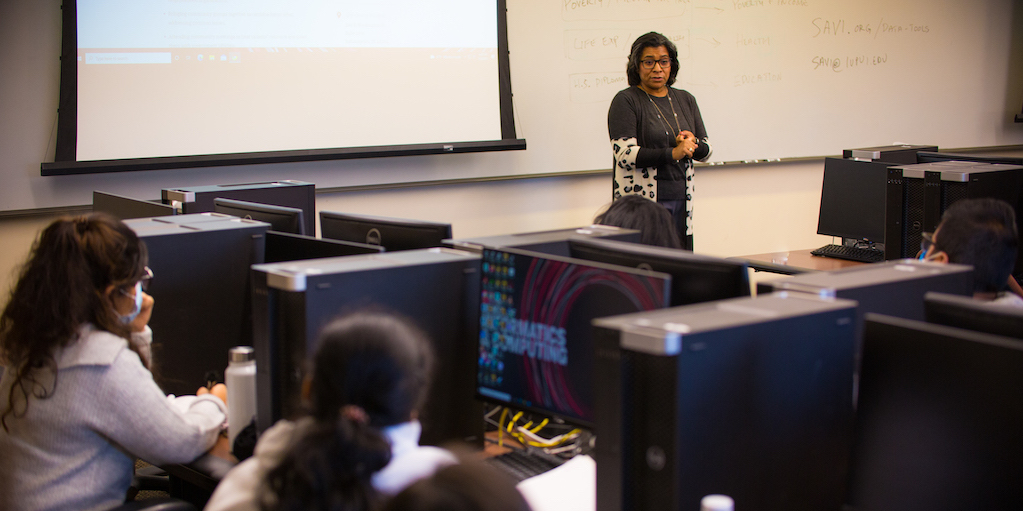Nearly 40 students combined their expertise to arrive at solutions to the 2021 Design Sprint challenge. Using design thinking principles and practices, teams were asked to conceptualize the 21st century neighborhood from identifying characteristics of success to addressing the difficult problems that some face. The overarching question was how any contributing factors—such as tangible, physical elements, service delivery, social interactions and enhancing technologies—could be re-conceptualized, applied, focused, or expanded to make neighborhoods better.
The sprint ran two weeks, from October 29 through November 15 and was sponsored by the Department of Human-Centered Computing and led by Media Arts and Science professor Steven Mannheimer. Indianapolis Deputy Mayor Judith Thomas (pictured above) visited the group on November 3 to offer some general expertise and plant some conceptual seeds for big-picture goals. Working in teams of four or five undergraduate and graduate students, winning teams arrived at and presented solutions to Kevin Armstrong, Executive VP and Chief of Staff at IU Health, and Professor Mannheimer.
Winning teams and their projects
FIRST PLACE ($700): Learn from Your Neighbors
The goal: To build a strong network within a community by leveraging knowledge or skill-set sharing sessions
This was an online neighborhood exchange/bartering system in which people in the neighborhood offered various expertise/services to other neighbors. For instance, one retired senior might offer after-school tutoring in reading for elementary school kids. In exchange, the tutor would receive a certificate of appreciation, the satisfaction of having made an important contribution to a neighbor’s welfare, and perhaps even some home-baked cookies from the parents. Almost any other type of expertise might be offered or bartered: learning a foreign language, lawn mowing, moving furniture, learning chess, etc. The neighborhood association would verify the identity and reputation of all participants.
Team members: Prachetas Gumaste, Pranali Shinde, Robin Singh, Shariwa Malankar, Yukta Karkera
SECOND PLACE ($500): A-R(evolution)
The goal: Create a service business that uses AR (Augmented Reality) technology to create customized virtual holiday light displays that can be seen via AR goggles or your smart phone.
As we have seen with Pokemon Go and other applications, AR is nowadays a relatively well-known technology that can be used to show users animations that appear to be superimposed over real physical structures and spaces. A key part of this is using GPS coding to exactly match the animation to the physical location. In this way, everyone in a neighborhood might use the service to create animated or stable images of holiday lights or 4th of July fireworks, etc., or these images might be generic decorations or customized for that specific neighbor, including picture of the kids or birthday greetings to grandma, etc., with text written by the neighbor. The entire neighborhood association might get together to buy a group rate, with artists and programmers from the A-R(evolution) service to fulfill individual requests.
Team Revolution members: Mayank Saxena, Vishal Phalke, Gagan Karvolu Gundyadka, Nahush Farkande
THIRD PLACE ($300): Do-Hood Donations
The goal: The basic idea of the Do-Hood project is to enable grocery shoppers in the check-out process in supermarkets in affluent neighborhoods to spontaneously donate groceries to residents in poorer areas.
Imagine a shopper about to pay their $100+ grocery bill when a touch screen offers them a chance to donate something (gallon of milk, can of corn, loaf of bread, box of oatmeal, pound of hamburger, etc.) needed by people in another part of the city. The key to this concept is a very easy-to-use touchscreen offering shoppers a limited list of donations with prices, and perhaps an image of the neighborhood where the donation will go, along with a cumulative record of their donations that year. Perhaps there are rewards for donors when they reach a certain level (“Congratulations! You have donated $100 to your neighbors this year. You are now entitled to a free cupcake from our Kroger bakery.”) The entire system would include a delivery service to distribution centers in the target neighborhoods, perhaps churches or schools. The service would keep track of what food items are most popular in which neighborhoods. Because many supermarket already include touchscreens for the self-check-out stations, this Do-Hood process could begin with a software application.
Team members: Bala Akhil, Rajdeep Battula, Apoorv Awasthi, Apoorva Nagesh, Tejaswini Parlapalli
FOURTH PLACE ($200): Community Gardens
The goal: This project focuses on the idea that the city’s existing community gardens could benefit from an online platform that helps them collaborate to plan events, coordinate their planting strategies to avoid duplication, and encourage bartering or trading of produce.
A city-wide harvest festival for all community gardens could attract attention to the movement, promote local produce for local restaurants, trade recipes, host competitions for bragging rights, etc.
Team Girls Next Door members: Aditi Shukla, Puja Mahtani, Shikha Trivedi, Vandana Munjal
HONORABLE MENTIONS
Team Eagle: Radhika Bezawada, Veena Mahesh, Manali Bhetaria, Sagar Mhatre, Nisha Nair—Crown Hill neighborhood food distribution and cooking classes
Nimisha Thakur—Umbrellas for loneliness and social isolation
Drew Avery—Gamified civic engagement for apartment dwellers
Media Contact
Joanne Lovrinic
jebehele@iu.edu
317-278-9208


